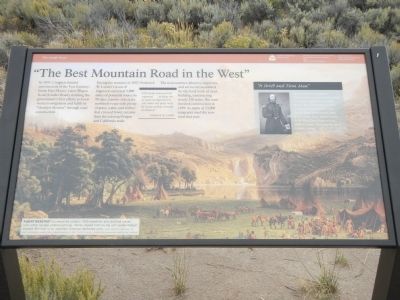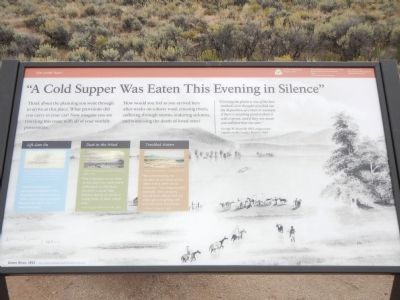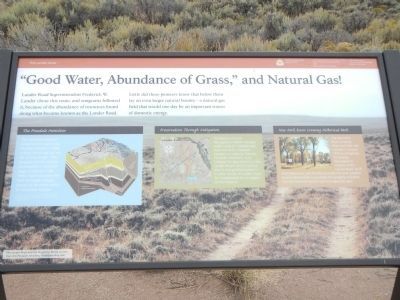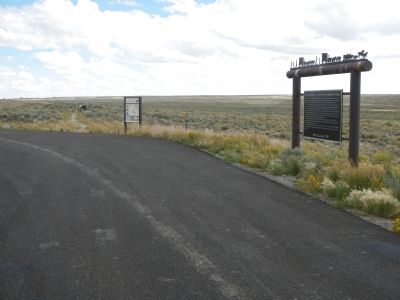Near Boulder in Sublette County, Wyoming — The American West (Mountains)
“The Best Mountain Road in the West”
“A Cold Supper Was Eaten This Evening in Silence”
— “Good Water, Abundance of Grass,” and Natural Gas! —

Photographed By Barry Swackhamer, August 24, 2014
1. “The Best Mountain Road in the West” Marker
Caption: Albert Bierstadt accompanied Lander’s 1859 expedition and sketched scenes, from which he later created paintings. Works created from this trip with Lander helped establish Bierstadt as an importent American landscape artist.
In 1857, Congress funded construction of the Fort Kearney-South Pass-Honey Lakes Wagon Road (Lander Road), marking the government’s first efforts to boost western emigration and fulfill its “Manifest Destiny” through road construction.
During the summer of 1857, Frederick W. Lander’s team of engineers surveyed 3,000 miles of potential routes in 90 days. Landers selected a northerly route with plenty of grass, water, and timber that crossed fewer streams than the existing Oregon and California trails.
The next summer, laborers, engineers, and surveyors assembled for the hard work of road building, constructing nearly 230 miles. This team finished construction in 1859. As many as 13,000 emigrants used the new road that year.
”(A)ll routes examined… to favor the ox team immigrants (sic) and water and grass must be found at short intervals of distance.” - Frederick W. Lander
Born in 1822 to a prominent Massachusetts family, Lander became a respected engineer by his early thirties. He surveyed and oversaw construction for a section of the Pacific Wagon Road known today as the Lander Road. Mount Lander in the Wind River Range and the town of Lander, Wyoming also carry Lander’s name.
Think about the planning you went through to arrive at this place. What provisions did you carry in your car? Now imagine you are traveling this rout with all your worldly possessions.
How would you feel as you arrived here after weeks on a dusty road, crossing rivers, suffering through storms, enduring sickness, and witnessing the death of loved ones?
”Crossing the plains is one of the best methods ever thought of to find out the disposition of a man or woman; if there is anything good in them it will crop out, and if they are mean you will find that out for sure.” - George W. Manville, 1863, wagon captain on the Lander Road in 1862
(Side bars)
Henry Hitchings, Album of sketches from an 1859 expedition to the West, with 68 drawings
Those traveling the westward emigrant trail developed mobile societies within which life continued despite the difficulties of overland travel.
William Henry Jackson, Desert Crossing at Night, 1867
“The wind
blew in our faces in the afternoon and nearly suffocated us with dust, the dust is worse than Indians, storms or winds or mosquitoes, or even wood ticks.” - Jane Augusta Hollbrook Gould, 1862.
William Henry Jackson, Crossing the River
“We crossed safely, no accidents at all. Some of the other trains were not so fortunate. Two wagons were capsized. One company lost all their effects and the other got everything wet and lost some few things.” - William H. Babcock, 1859
Lander Road Superintendent Frederick W. Lander chose this route, and emigrants followed it, because of the abundance of resources found along what became known as the Lander Road.
Little did these pioneers know that below them lay an even larger natural bounty - a natural gas field that would one day be an important source of domestic energy.
(Side bars)
The California Company drilled the first well in the Pinedale Anticline in 1939, finding natural gas but not the oil they sought. They plugged the hole and left. Development of the field began in earnest in the 1990s. Experts estimate the field can supply enough energy for 30
million homes for more than 30 years.
The Bureau of Land Management (BLM) manages public lands for multiple uses and must strike a balance between competing interests. The BLM, therefore, must mitigate for degradation to the Lander Road’s historic setting due to energy development - in other words, the public must be compensated for an impact to this resource.
The New Fork River Crossing Historical Park was created in August 2010 as mitigation for energy development impacts to the Lander Road. Shell, Ultra Resources, and PacifiCorp made the park possible by providing funds to purchase the property. Sublette County Historical Society now manages the park.
Erected by Wyoming State Historic Preservation Office, Oregon-California Trail Association, Bureau of Land Management.
Topics. This historical marker is listed in these topic lists: Industry & Commerce • Roads & Vehicles. A significant historical year for this entry is 1857.
Location. 42° 37.552′ N, 109° 39.504′ W. Marker is near Boulder, Wyoming, in Sublette County. Marker is on U.S. 191 near Emigrant Trail, on the left when traveling north. Touch for map. Marker is in this post office area: Pinedale WY 82941, United States of America. Touch for directions.
Other nearby markers.
At least 8 other markers are within 10 miles of this marker, measured as the crow flies. To All Pioneers Who Passed This Way to Win and Hold the West (within shouting distance of this marker); Sand Springs - A Stop on the Oregon Trail (within shouting distance of this marker); Lieutenant J.C. Fremont's Week in Sublette County (approx. 9 miles away); New Fork River Crossing (approx. 9.7 miles away); Rising to the Challenge of the New Fork River (approx. 9.8 miles away); Crossing the New Fork River (approx. 9.8 miles away); "We Busy Ourselves in Various Ways" (approx. 9.8 miles away); The First Engines: Oxen, Mules, and Horses (approx. 9.8 miles away). Touch for a list and map of all markers in Boulder.
More about this marker. This marker is a short walk south from the Sand Spring marker pullout.
Credits. This page was last revised on June 16, 2016. It was originally submitted on January 30, 2015, by Barry Swackhamer of Brentwood, California. This page has been viewed 546 times since then and 22 times this year. Photos: 1, 2, 3, 4. submitted on January 30, 2015, by Barry Swackhamer of Brentwood, California. • Andrew Ruppenstein was the editor who published this page.


